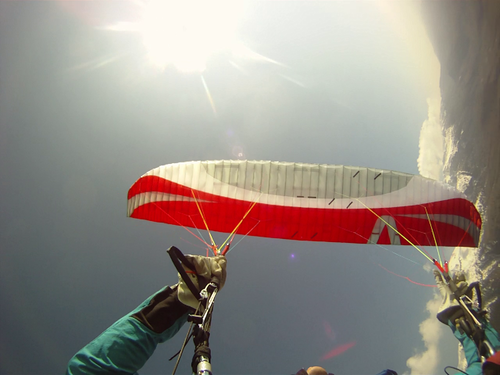Skywalk Chili3 M |
|||||||||||||||||||||||||||||||||||||||||||||||||||||||||||||||||||||||||||||||||||||||||||||||||||||||||||||||||||||||||||||||


|
|||||||||||||||||||||||||||||||||||||||||||||||||||||||||||||||||||||||||||||||||||||||||||||||||||||||||||||||||||||||||||||||
Instability rating |
|||||||||||||||||||||||||||||||||||||||||||||||||||||||||||||||||||||||||||||||||||||||||||||||||||||||||||||||||||||||||||||||
|
|||||||||||||||||||||||||||||||||||||||||||||||||||||||||||||||||||||||||||||||||||||||||||||||||||||||||||||||||||||||||||||||
Glider characteristics |
|||||||||||||||||||||||||||||||||||||||||||||||||||||||||||||||||||||||||||||||||||||||||||||||||||||||||||||||||||||||||||||||
|
Launch preparations: average
launch characteristics: dynamic, climbs constantly, no guidance necessary, good feedback during inflation, overshoots, pronounced braking required, accelerates before zenith, control check simple, low takeoff speed
asymmetric collapse: canopy collapses at low angle to leading edge, high dynamics, total course change 270-360°, (4), fast course change rate, high forward pitching 75-90°, (5), high height loss 40-49 m, (3), high sink velocity 20-24 m/s, (3), collapse on opposite wingtip with course change <90°, (4), G-Force 2,5- 2,9 G, (2)
Frontal collapse: canopy collapses with low total collapse area, marked pitch backwards 45-60°, marked pitch forwards 45-60°, moderate dynamics, course change 90-180°, (3), delayed recovery, asymmetric recovery, delayed return to normal airspeed, delayed reinflation of wingtips, with tendency to cravat, (4), high height loss 40-49 m, (3), low sink velocity 10-14 m/s, (1)
Spiral dives: rapid sink velocity increase, Moderate G-Force 3,5- 4.0 G, (2), Sink velocity after 720° <18 m/s, (3), Moderate maximum sink velocity < 18 m/s, (2), no increase of sink velocity on brake release (1), Course change 90-180° after spiral exit, (1), moderate height loss during recovery 30-60 m, (2)
B-Stall: normal force required, moderate pitch backwards 15-30°, moderate pitch forwards 15-30°, stable sink phase, immediate return to normal airspeed, 8-10 m/s, height loss on recovery < 20 m
big ears: simple initiation, unsteady flight phase, wingtips flatter markedly, delayed automatic recovery, Vsink unaccelerated 2,5-3 m/s, Vsink accelerated 4-4,5 m/s, Vunaccelerated 3-5 km/h less than trimspeed, Vaccelerated >8 km/h faster than trimspeed |
|||||||||||||||||||||||||||||||||||||||||||||||||||||||||||||||||||||||||||||||||||||||||||||||||||||||||||||||||||||||||||||||
Notes |
|||||||||||||||||||||||||||||||||||||||||||||||||||||||||||||||||||||||||||||||||||||||||||||||||||||||||||||||||||||||||||||||
|
Launch characteristic: Skywalks Chili 3 also climbs constantly and not too fast to the zenith, but needs more brake input to stop it there and stabilise the canopy. Asymmetric Collapse: Similar to its predecessor, the Skywalk Chili 3 has it's own special collapse behaviour. The canopy only folds along a shallow collapse angle across the leading edge. Even when pulling massive collapses, the canopy does not fold steeply, so most of the trailing edge remains flying. To provoke LTF norm collapses, the test pilot must use both hands and lots of dynamic force to make the trailing edge deform. If this is performed, then the glider dives well forward and often then cascades with a collapse on the opposite wingtip. We didn't note any tendency for the canopy to cravat, as with the Chili 2, where the wingtip would often catch between the upper gallery lines. Front collapses: 40% Moderate pitch back, low pitch forward, immediate recovery, no course change, low sink rates Maximum collapse presented by construction: Marked pitch back and pitch forward. Spiral Dive: The spiral test produced no great surprises.No glider demonstrated tendencies to remain in a stable dive after the brakes had been released to initiate recovery. High end B class gliders do tend to collapse on the outer wingtip when spiralling due to their higher aspect ratios. These small collapses produce sufficient resistance to prevent the gliders accelerating further in the spiral. Here all spirals were flown according to LTF test regulations without using weight shifting. Spirals flown in practice by pilots using weight shifting and stabilising the outer wingtip sufficiently to prevent it collapsing may well lead to further acceleration in the dive and produce a stable spiral dive once the brakes are released to initiate recovery. B-Stall: Skywalk Chili 3, Mac Para Eden 5 and Icaro Wildcat did not have any difficulties with this manoeuvre. Big Ears: The two gliders with only two main A Lines (Gradient Nevada and Skywalk Chili 3) had the most effective sink rates. Ears flap at full speed. |
|||||||||||||||||||||||||||||||||||||||||||||||||||||||||||||||||||||||||||||||||||||||||||||||||||||||||||||||||||||||||||||||
Rating |
|||||||||||||||||||||||||||||||||||||||||||||||||||||||||||||||||||||||||||||||||||||||||||||||||||||||||||||||||||||||||||||||
|
Safety class 5 This class of paraglider reacts very demandingly to one or more of the following manoeuvres: frontal collapse, asymmetric collapse or spiral dive and may present pilots with a particular challenge.Very demandingly means that the above manoeuvres result in highly dynamic reactions from the glider, and/or large height losses. Critical subsequent glider reactions are also to be expected. Expert piloting skills achieved through constant practice, fast personal reaction times and precise pilot inputs are required to be able to immediately react to the above manoeuvres to maintain flight control and prevent large height loss or subsequent critical glider reactions. In particular, pilots should be able to recognise the onset of the above manoeuvres and be able to prevent or minimise their effects through immediate and precise pilot inputs. |
|||||||||||||||||||||||||||||||||||||||||||||||||||||||||||||||||||||||||||||||||||||||||||||||||||||||||||||||||||||||||||||||

